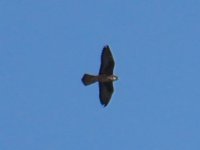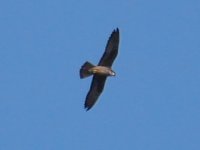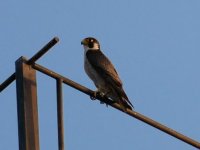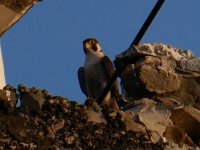MaxesTaxes
Well-known member

Hi all,
I had a lovely time in Sicily (Italy) a couple weeks ago and was namely able to add a couple lifers to my ever-growing list.
I am however struggling with identifying these falcons, especially the first one (the blurry photos don't help, sorry for that). Both were spotted from the deck of the cruise ship we took to visit Stromboli and the surrounding area. All from July 28th this year.
The first one was seen flying in circles around the Isola di Basiluzzo, a tiny island made of tall igneous rocks. There were two individuals but I only took photos of one. It seems darker than Peregrine Falcons typically are, and it seems to have a rusty leggings/vent area, which made me think this was a Eurasian Hobby (Falco subbuteo). Size was hard to make out given the bird was very far away, but it did seem smaller than your average Peregrine. However what's making me hesitate is the behavior and even more the location: I've read that Hobbys are very fast acrobatic flyers that favor woodlands/farmlands with trees to stand in, whereas this bird was essentially out at sea slowly flying over a small vegetation-barren island.


The second individual I am fairly certain is a Peregrine Falcon (Falco pelegrinus) as the more 'horizontal' chest pattern is characteristic. However the location of this bird again makes me second guess whether this definitely is a Peregrine - it was seen on the Strombolicchio, an even smaller igneous rock "island" completely barren of vegetation.


The reason I'm being hesitant with my ID's here is because both birds were seen relatively far away from any area suitable for their typical dietary needs - having to do a daily trek to Stromboli or Panarea must be an unnecessary waste of energy. So (given that these are indeed a Hobby and a Peregrine respectively), my follow-up question is why would they choose to live in such remote areas, away from good food sources? What ecological advantage do these remote rocky islands provide that's so great it makes it worth to fly large distances for food (and maybe also partners)?
I've also found out that the Eleonora Falcon (Falco eleonorae) is famously known from the Aeolian Islands/Sicily, and that it is indeed better adapted to the 'island life'. However eBird does not seem to suggest its occurrence as possible here at this time of year (maybe just a lack of data?). I don't find the Eleonora Falcon to be a great match with my birds though (at least not the second one), so that may not be relevant here.
Thanks in advance for your insights!
Best,
Max
I had a lovely time in Sicily (Italy) a couple weeks ago and was namely able to add a couple lifers to my ever-growing list.
I am however struggling with identifying these falcons, especially the first one (the blurry photos don't help, sorry for that). Both were spotted from the deck of the cruise ship we took to visit Stromboli and the surrounding area. All from July 28th this year.
The first one was seen flying in circles around the Isola di Basiluzzo, a tiny island made of tall igneous rocks. There were two individuals but I only took photos of one. It seems darker than Peregrine Falcons typically are, and it seems to have a rusty leggings/vent area, which made me think this was a Eurasian Hobby (Falco subbuteo). Size was hard to make out given the bird was very far away, but it did seem smaller than your average Peregrine. However what's making me hesitate is the behavior and even more the location: I've read that Hobbys are very fast acrobatic flyers that favor woodlands/farmlands with trees to stand in, whereas this bird was essentially out at sea slowly flying over a small vegetation-barren island.


The second individual I am fairly certain is a Peregrine Falcon (Falco pelegrinus) as the more 'horizontal' chest pattern is characteristic. However the location of this bird again makes me second guess whether this definitely is a Peregrine - it was seen on the Strombolicchio, an even smaller igneous rock "island" completely barren of vegetation.


The reason I'm being hesitant with my ID's here is because both birds were seen relatively far away from any area suitable for their typical dietary needs - having to do a daily trek to Stromboli or Panarea must be an unnecessary waste of energy. So (given that these are indeed a Hobby and a Peregrine respectively), my follow-up question is why would they choose to live in such remote areas, away from good food sources? What ecological advantage do these remote rocky islands provide that's so great it makes it worth to fly large distances for food (and maybe also partners)?
I've also found out that the Eleonora Falcon (Falco eleonorae) is famously known from the Aeolian Islands/Sicily, and that it is indeed better adapted to the 'island life'. However eBird does not seem to suggest its occurrence as possible here at this time of year (maybe just a lack of data?). I don't find the Eleonora Falcon to be a great match with my birds though (at least not the second one), so that may not be relevant here.
Thanks in advance for your insights!
Best,
Max






